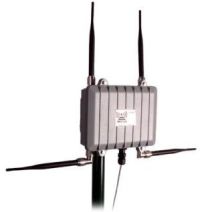X86 WiFi mesh routers run Debian Linux
Jun 10, 2008 — by Eric Brown — from the LinuxDevices Archive — 61 views Saxnet is shipping three versions of its Debian Linux-powered wireless mesh-networking router. The standard Meshnode III offers a self-organizing transmission system with up to four 100 mW 802.11a/b/g radios, while a “Power” version ups the Wattage to 600 mW and a “Custom” version adds hardware customizability.
Saxnet is shipping three versions of its Debian Linux-powered wireless mesh-networking router. The standard Meshnode III offers a self-organizing transmission system with up to four 100 mW 802.11a/b/g radios, while a “Power” version ups the Wattage to 600 mW and a “Custom” version adds hardware customizability.
(Click for larger view of the Meshnode III Power)
“Mesh” routers such as the Meshnode III are designed for rapid deployment in areas lacking infrastructure. Typically, the routers discover one another transparently, and self-configure themselves into a daisy-chain arrangement, in which each router serves as a repeater for the others. Thus, users can extend the range of their network by adding more devices. Examples of other mesh routers include Libelium's Meshlium, the Meraki Mini, and the Marvell Libertas controller and radio built into the One Laptop per Child XO system.
The original Meshnode was a modest dual-radio device, but the Meshnode III is equipped with up to four “OSI Layer 2-compatible” radio modules, says the German networking equipment integrator. Announced in October, the Meshnode III offers one to four 100 mW radios for the standard model and four 600 mW radios for the Power model. Powered by 500MHz AMD Geode LX 700 CPUs, the Meshnode III models offer 128MB of RAM (512MB for the Power model), and 512MB of flash memory (1GB for the Power model). They are also equipped with wired Ethernet and USB ports.

Left to right: the Meshnode III, the Meshnode III Power, and the Meshnode III Custom
(Click to enlarge)
The Meshnode III supports IP69K protection-class standards with its water- and UV-resistant Makrolon casing, says Saxnet. Its heating and cooling system is said to help protect against temperatures ranging from -40 to +75 degrees C.
The Power model offers greater mesh coverage and more potential clients than the standard model, says Saxnet. The Custom model, meanwhile, offers a choice of WLAN cards, RAM size, filesystem allocations, and memory card capacity. Additionally, the Custom model offers an expansion slot of unspecified type within the enclosure, with the aim of letting users integrate the device with warehousing or production monitoring equipment.
For large networks, any Meshnode can be dedicated as a controller that runs network management and monitoring software. The Debian-based management software includes features such as graphical mapping of individual nodes, Saxnet says.
The Meshnode III's specs, which have changed somewhat since the original announcement, are listed as follows:
- Processor — 500MHz AMD Geode (X86) LX 700 (standard), 800, 900
- Memory — 128MB RAM (Power model 512MB)
- Flash — 512MB (Power model 1GB)
- WLAN — 1 to 4 x 802.11a/b/g radios (5GHz/2.4GHz/2.4GHz, respectively); Power model 4 x radios
- WLAN aerial ports — 8 x N-female (4 x diversity)
- WLAN power — 100 mW (Power model 600 mW)
- Networking — 1 x 10/100/1000 Ethernet
- USB — 1 x USB 2.0
- Mesh technology — OSI Layer 2 with ad-hoc and infrastructural mode
- Security — WEP/WPA/WPA2
- Dimensions — 14 x 11 x 3.9 inches (360 x 280 x 100 mm)
- Weight — 9.9 lbs (4.5 kg)
- Power supply — 90 – 264 VAC, 47 – 63 Hz
- Operating temperature — -40 to +75 degrees C (@ 100% humidity)
- Operating system — Debian GNU/Linux, with 2.6.21 kernel



Evolution of a Mesh router, left to right: the original Meshnode, the Meshnode III prototype,
and the shipping Meshnode III standard version
Availability
The Meshnode III is available now in its three configurations. Saxnet did not provide pricing for the various models.
This article was originally published on LinuxDevices.com and has been donated to the open source community by QuinStreet Inc. Please visit LinuxToday.com for up-to-date news and articles about Linux and open source.